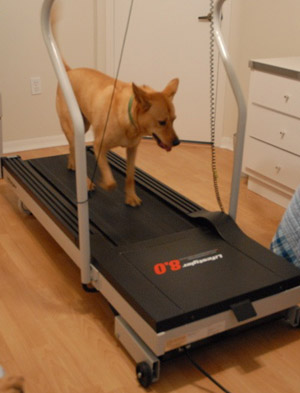Treadmill Exercise for Dogs
 Did you know that treadmill exercise for dogs can benefit their health and behavior?
Did you know that treadmill exercise for dogs can benefit their health and behavior?
And the best part is that they generally get completely hooked on the exercise and start begging for the activity. My dog goes to the treadmill and barks until I turn it on for her. One client’s dog goes to the treadmill and stands on it…his owner gets the message!
We’re not surprised; we hear stories like this all the time. Dogs not only need exercise, they love it!
If you don’t read any further, the five most critical things to know are:
- For the safety of your dog, do not attempt treadmill training without the guidance of a professional dog trainer who is experienced in treadmill work.
- Go slow! Don’t go too fast or try to cover too many miles. Set an easy pace.
- Never force your dog to get on or stay on the treadmill.
- Never, ever, ever, tie your dog to the treadmill.
- Unless you have a treadmill made specifically for dogs (the machine turns itself on and off with the dog’s movement), never leave your dog unattended while he is on the treadmill.
As with all physical exercises, the goal is to provide your dog with a healthy lifestyle. Regularly exercising your dog on a treadmill not only helps to strengthen muscles, it is also a powerful stress reliever. This is ideal for those dogs who are high-energy, who are cooped up in the house for extended periods of time and those who “act out” with destructive behaviors as a result of too little exercise. Remember, dogs are living breathing mammals, and they build up a lot of energy. If we don’t provide a regular release for their energy, it will manifest itself in negative behaviors such as excessive barking, chewing, digging, running in circles, or destroying toys, furniture or other items.
Additional benefits of treadmill exercise:
- Increases your dog’s general endurance and muscle tone
- Provides your dog with versatility in exercise
- Provides your dog with exercise in adverse weather
- Helps relieve stress in high energy dogs
- Substitutes for dog owners who are not physically able to walk their dogs
Use the treadmill as a supplement to, not a replacement for, daily walks outside.
Unless you are physically incapable of walking your dog, the treadmill exercise does not replace the need for regular, daily walks. In fact, it is most effective when it is applied immediately before or after the dog’s regular walk. The total exercise time lengthens, allowing the dogs to completely blow off the steam they have built up. In comparison, a typical 15-20 minute walk will not offer the same advantages to your dog and they often return home as energetic as when they left.
Be sure to talk with your veterinarian before beginning a treadmill routine with your dog trainer. For the dog’s safety and well-being, they must be physically stable with no heart, muscular, joint or bone problems.
Using a treadmill to keep your dog in top physical shape can be a wonderful experience for your dog. However, if the treadmill is used improperly, and the introduction is not pleasant for your dog, it will not be a good experience and may be physically dangerous. Never attempt treadmill training without consulting with a professional dog trainer who is experienced in treadmill training. Your first consideration should always be what is best for the dog.
The goal of all dog training is to provide peaceable solutions to everyday problems so that pets and their owners live harmoniously. Paws in Training provides dog and cat training services in Raleigh, Apex, Holly Springs, Cary, Fuquay Varina and Garner, N.C.

